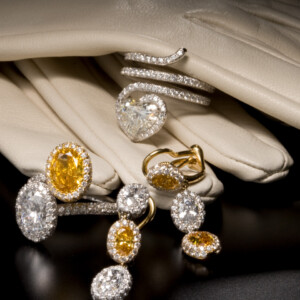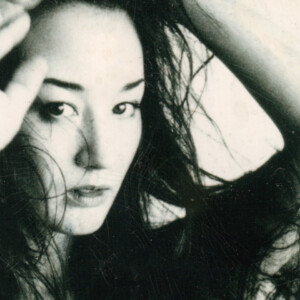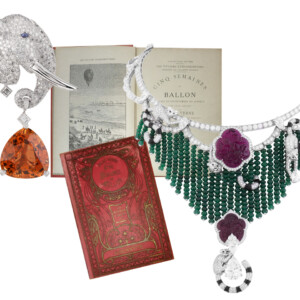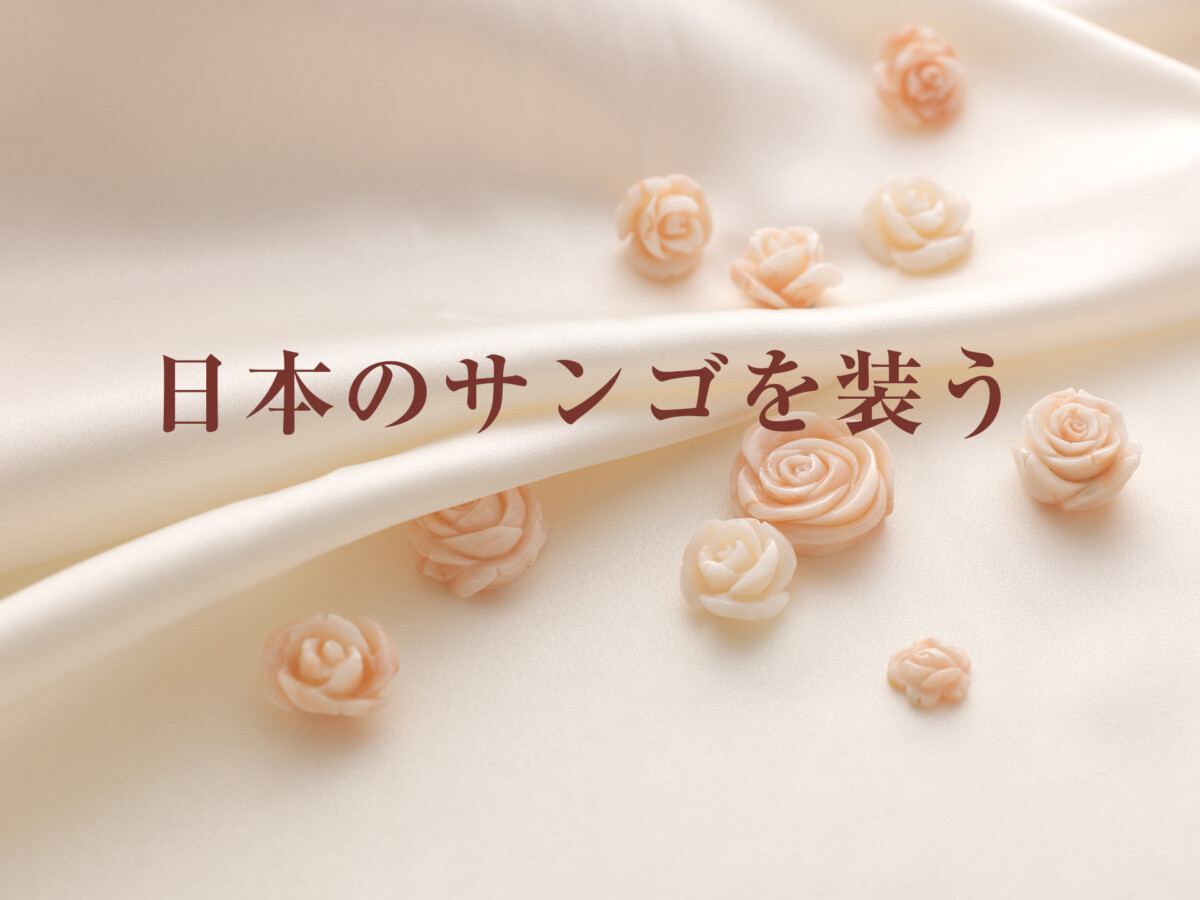
サンゴを装う
English follows Japanese
珊瑚には、お土産などカジュアルなアクセサリーや小物に利用される造礁珊瑚と、高級品となる宝石珊瑚に分かれます。日本の高知の海で採られる宝石珊瑚は、高級宝飾品のための素材として世界で認知されていますが、日本ではあまり知られていません。日本でジュエリーといえば、誰もが真珠を思い浮かべ、その高い品質を誇りにしています。宝石珊瑚は、成長に時間がかかり量産ができないため、真珠以上に希少な素材。珊瑚自体が高級宝石そのものと言えます。ここでは宝石珊瑚の美しさをフィーチャーします。
明治時代、高知県で珊瑚漁が始まると、
ヨーロッパの珊瑚職人はあまりの大きさに驚いた
日本の宝石といえば誰もが真っ先に思い浮かべるのは真珠です。しかし、真珠が登場したのは養殖真珠が成功した1893年(明治26年)です。それ以前、真珠は天然真珠なのであまりに小さく、宝石はサンゴやべっ甲が中心で、象牙、メノウや水晶などもありました。特に赤い珠のサンゴは女性の憧れでした。
江戸文化の爛熟期、文化・文政期(1804年)以降、サンゴをあしらった髪飾りが流行します。当時日本ではまだサンゴを採取はされていなかったので、はるばる異国から持ち込まれた舶来品で、今でも博物館で当時の櫛を見ることができますが、象牙に桃色のサンゴや螺鈿、べっ甲の櫛に鮮やかな朱があしらわれ、まさに宝飾品です。江戸、明治、昭和と、女性たちは和装に合わせてサンゴの付いた櫛や帯留めをひとつくらいは必ず持つようになりました。
イタリアで見た高知県産の宝石珊瑚
『ブランドジュエリー』編集部では定期的に海外のジュエリー展示会の取材に行きます。イタリアの最大規模のジュエリーショー「ヴィチェンツァ・オロ」である時、意外な発見をしました。あまりにもきれいな赤、ピンクの光沢のきれいなサンゴを使ったセンスのいい高級品のジュエリーに目が止まり、その展示ブースを覗いてみると、「これはあなたの国、高知県のサンゴですよ。大きくて色も最高に美しい」。日本から来たことを告げると、販売の女性が説明してくれたのです。日本のサンゴはイタリアでモダンな形に研磨され、大ぶりのネックレスやリングに加工され、堂々とハイジュエリーのコーナーに並んでいました。
欧米の女性はさまざまなタイプのジュエリーを身に着けますが、艶やかな色の血赤サンゴも好きなアイテムのひとつです。イタリアの宝石店のサンゴは、地中海サンゴが中心ですが、地中海サンゴは原木の枝が細く、内部にキズや白濁などの欠点を持っているものが多く、高級品にはほど遠い品質です。そうした理由もあって、高級なサンゴジュエリーには日本から輸入した宝石珊瑚が使われます。日本沿岸で採れる宝石珊瑚は、大きさ、品質ともに地中海産とは比較にならないほど良質なのです。とりわけ血赤サンゴとなるアカサンゴの原木は日本固有のものです。
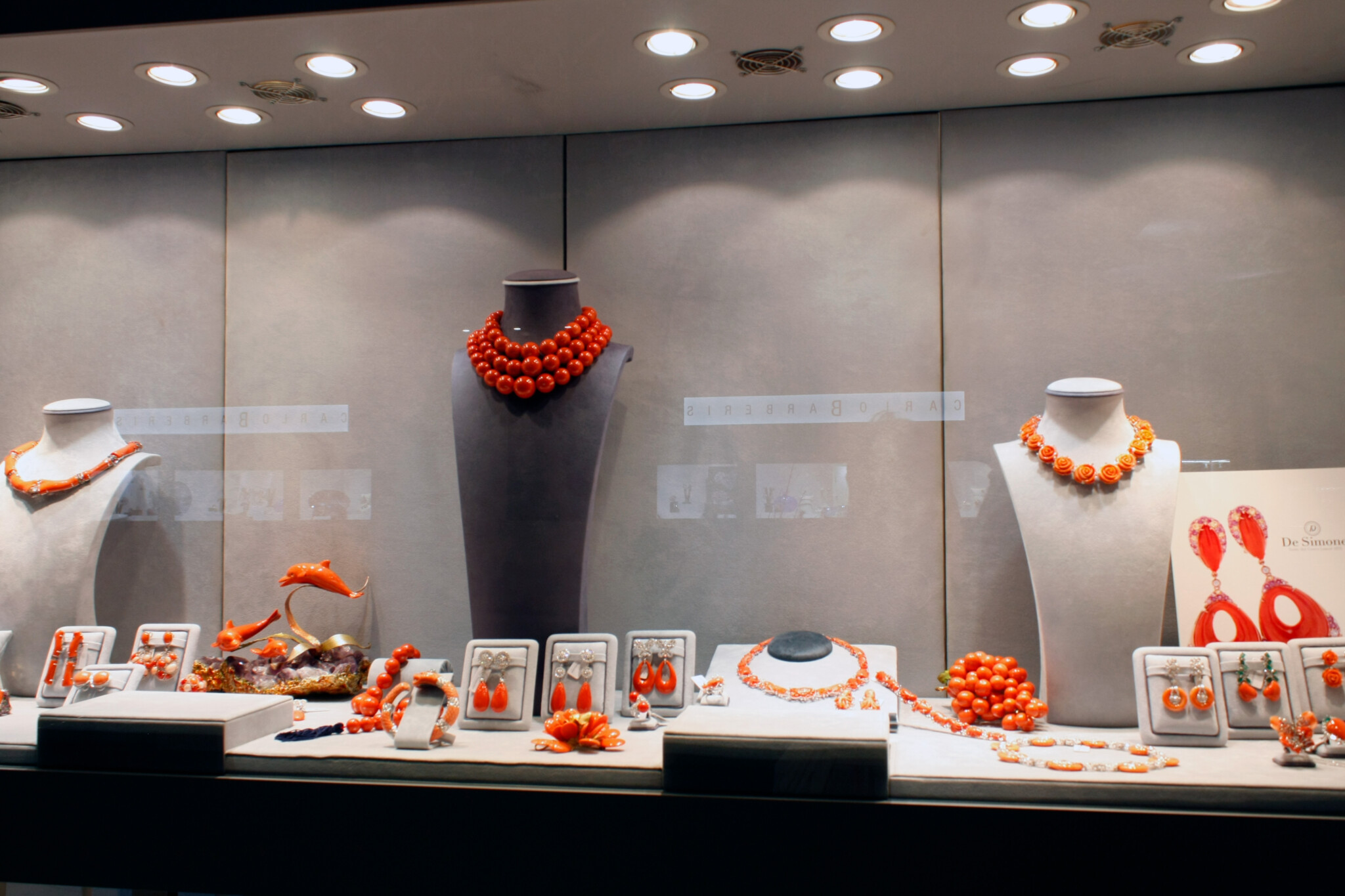
宝石珊瑚と造礁珊瑚
地中海のサンゴ、日本のサンゴ、どのような違いがあるのでしょうか。サンゴには海岸の浅瀬で見受けられる造礁珊瑚と、深海に生息する宝石珊瑚があります。造礁珊瑚は成長が早く軽石のような状態なので、研磨しても光沢は現れません。一方、宝石珊瑚と呼ばれるサンゴは丹念に磨くと美しい光沢が生まれます。きれいな色艶が現れるのは、サンゴの中心部に形成された原木と呼ばれる骨軸の部分です。
地中海サンゴの原木は、水深50〜200メートルの海底に生息し、平均的な高さは20〜30センチ、枝の広がりは10〜15センチ、枝の直径は5〜6ミリ以下のものが中心です。細いので大きな珠を作ることはできず、ほとんど小さなビーズになります。
日本の宝石珊瑚の中で特に高値で取引されるのは血赤サンゴです。日本近海、特に土佐湾の100〜300メートル程度の深海でゆっくりと成長します。平均的な高さは30センチ、根元の直径が3センチと、これも大きくはありません。海底に扇のように枝を広げてくっついていて、そのまま採取したものは観賞用として人気です。大きなルースが採れるのは根元のごく一部なので、丸珠の場合、直径7ミリ以上は高価で、10ミリ以上を超えるものは希少です。色はこれ以上濃い赤はないほど濃い赤で艶があり、もちろん「フ」(年輪の中心にある白色)や「ヒ」(縦方向のひび)、またキズがないものです。
宝石珊瑚ではその他に最近人気のピンクサンゴがあります。ピンクサンゴは柔らかい色合いから「エンゼルスキン」「ボケ」と呼ばれてきました。ピンクサンゴは主にモモイロサンゴという原木から採取されます。モモイロサンゴは深海200〜500メートルに制作し、高さは1.5メートル、根元の直径が15センチとアカサンゴよりも大きく成長します。色はできるだけ均質で、色むらがないものを選ぶのがいいでしょう。
近頃、白いサンゴも見るようになりましたが、真白なシロサンゴはレアです。シロサンゴは南シナ海、沖縄近海、五島列島、長崎沖、土佐湾など、日本近海の水深100〜400メートルのところに分布しています。ピンク色を基調に白色が混ざり合う傾向があります。セピア色の色調も注目を集めています。
宝石珊瑚はいずれも深いに海に生息するので、採取に費用がかかります。また枝の太さから考えてみても大きな珠が作れないことは容易に想像できます。宝石珊瑚は一生もののジュエリーです。女性のお守りとして、もちろん最近では赤、ピンク、白、セピアといろいろな色のサンゴをダイヤモンドや宝石と組み合わせて高感度なサンゴジュエリーが登場しているので、おしゃれとしても素敵です。サンゴは磨き直しができるので、長年使っていて、光沢がぼんやりしていたら、購入店や専門店に相談するとよいでしょう。サンゴは真珠と同じように日本の宝石です。その柔らかな光沢は日本の女性の肌になじみ、身に着ける人の魅力を引き出してくれるでしょう。
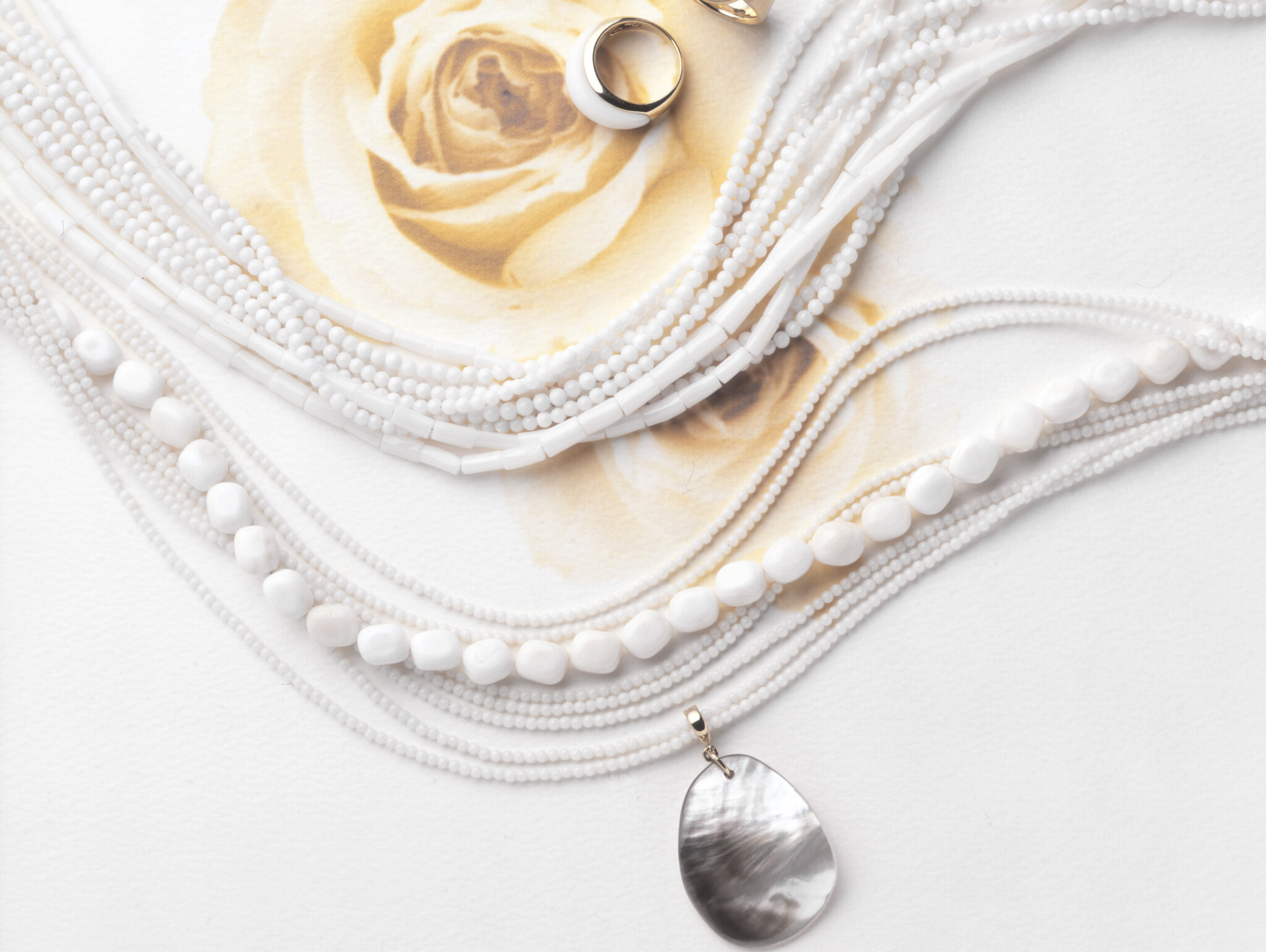
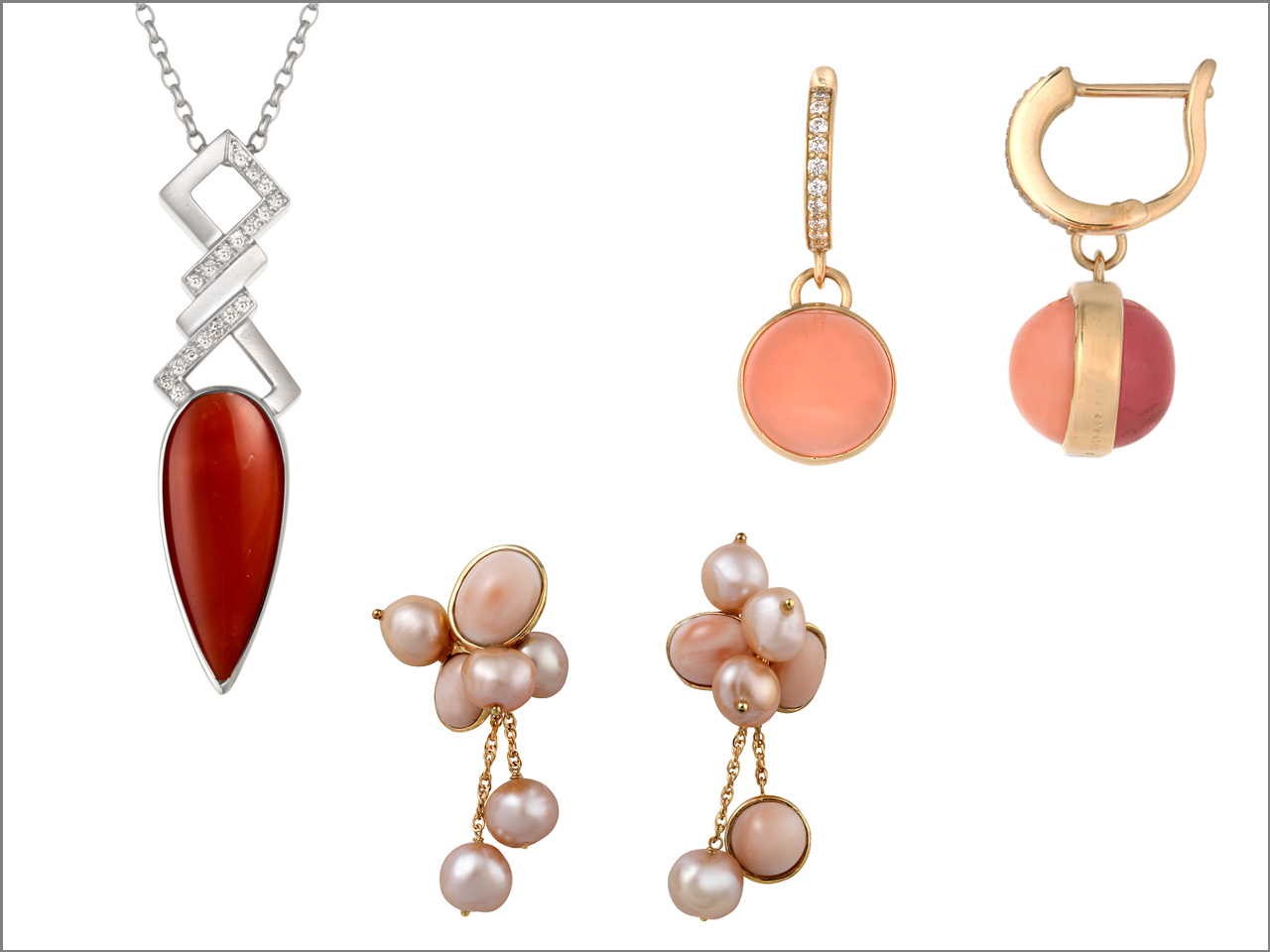
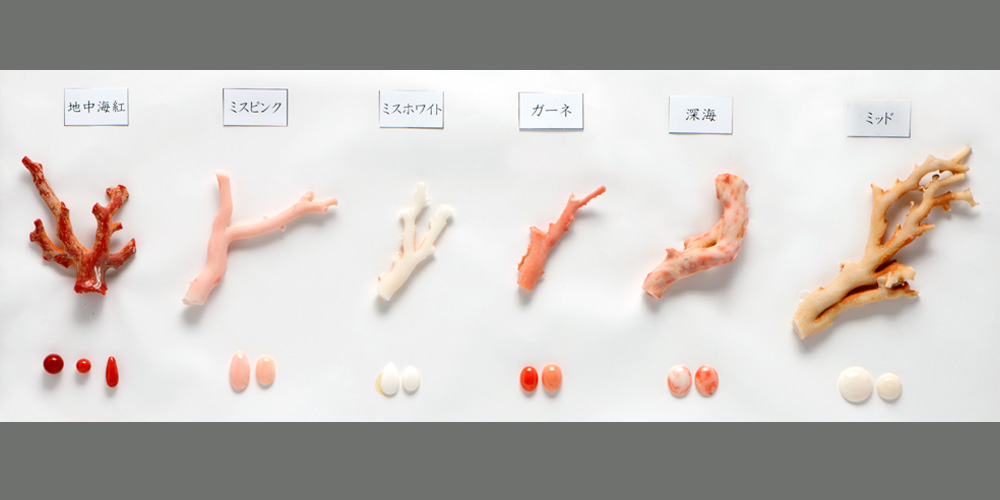
何万年も前から人々に愛されたサンゴ
サンゴの歴史は25000年以上にもさかのぼり、旧石器時代の遺跡からも発掘されたとされています。ギリシャ神話では「ペルセウス」と「メデューサ」の戦いでメデューサの血が海草に触れたとたん海草はサンゴに姿を変えたといわれ、キリスト教では十字架に架けられたイエス・キリストが流した血の色と考えられたそうです。そんな言い伝えからローマ帝国の時代には災難から身を守る魔よけとして使用され、十字軍の戦士のお守りとして用いられていたことは有名です。やがてその美しさゆえに装身具として身に着けるようになっていきます。時を経てシルクロードより日本へ伝わったのは仏教伝来の時期。聖武天皇に謙譲されたといわれており、正倉院にはサンゴ玉を配した冠が残っているそうです。
江戸時代後半、サンゴの歴史が大きく変わります。それまで地中海サンゴが主流でしたが、日本国内で宝石珊瑚の採取がスタート、明治時代から急速に発展していきました。それから約200年近くたった現在。サンゴの産地は地中海沿岸部とハワイ群島周辺、日本近海とされており、日本は世界的に有名なサンゴ産地国へと発展したのです。特に高知で取れるアカサンゴは良質とされており世界中のジュエラーから熱い視線を浴びています。
わずか5種類しかない貴重な宝石サンゴ
海の浅いところで生息しているサンゴは研磨しても光沢を放つことはありません。そのため宝石サンゴは水深100メートル以上の深海に生息するものに限られます。ジュエリーとして使われるのは、アカサンゴ、深海サンゴ、ピンクサンゴ、シロサンゴ、地中海サンゴの5種類のみ。わずか1センチ成長するのに50年もの時を要する種類もあるといわれ、数百年の時間を経てジュエリーとして採取されるものも珍しくありません。深みのある色合いと独特の光沢感は海底で長年の時をかけ自然が育んだ証なのです。
アカサンゴ
日本固有の種類高知県沖の海底に多く生息し、独特の赤色と品質の良さから海外へも輸出されています。赤黒いものはオックスブラッドとも呼ばれ人気があります。
地中海サンゴ
地中海全域で採れるサンゴ。枝が10〜15センチと小ぶりなので、大きな宝石にはなりまん。色むらがなくきれいなわりに、価格がそれほど高くないために人気があります。
シロサンゴ
五島列島、沖縄、土佐湾など東シナ海から日本近海の推進100〜400メートルに生息。特に象牙色(淡黄白色)のものは希少性が高く、価値があるとされています。
ピンクサンゴ
別名エンゼルスキンと呼ばれ、日本近海で多く採取されます。色はほのかなピンクからオレンジ、赤に近い色味のものがあり童話に登場するほど昔から親しまれています。
深海サンゴ
東シナ海、ハワイ群諸島で多く採取され、水深1000メートル以上の海底に生息しています。白色に赤い模様を持ったもの、ピンク色に赤い模様を持ったものがあります。
Coral is divided into two types: reef coral, which is used for casual accessories and small objects such as souvenirs, and gem coral, which is a luxury item. Jewelry coral from the seas of Kochi, Japan, is recognized globally as a material for high-end jewelry, but it is not well known in Japan. When people think of jewelry in Japan, everyone thinks of pearls and takes pride in their high quality. Jewelry coral is rarer than pearls because it takes time to grow and cannot be mass-produced. Coral itself can be considered a luxury gemstone itself. Here we feature the beauty of gem coral.
Pearls are the first thing that comes to everyone’s mind when we think of Japanese jewelry. However, pearls were not familiar until 1893, when cultured pearls were successfully produced. Before that, pearls were only natural and were too small to wear. Generally, it is considered that gemstones were mainly coral and tortoiseshell, as well as ivory, agate, crystal, and other gems. Especially, women preferred round-shaped coral.
After the Bunka-Bunsei period (1804), when the Edo culture was in the golden age, hair ornaments decorated with coral became popular. Since coral was not yet harvested in Japan in those days, they were imported goods from foreign countries, and even today you can see combs from that period in museums. In the Edo, Meiji, and Showa periods, women always had at least one coral comb or obidome (sash belt for kimono) to match their kimono.
The editors of Brand Jewelry regularly go to cover jewelry exhibitions abroad. One time at Vicenza Oro, the largest jewelry show in Italy, I made a surprising discovery. A tasteful, high-end piece of jewelry with beautiful red and pink lustrous coral that was so beautiful that it caught my eye when I looked into the exhibition booth, I was told, “This is coral from your country, Kochi Prefecture. It is a large and has the most beautiful color”. When I told her I was from Japan, the saleswoman explained. Japanese coral had been polished into modern shapes in Italy, processed into large necklaces and rings, and proudly displayed in the high jewelry section.
Western women wear many different types of jewelry, and the lustrous color of blood-red coral is one of their favorite items. Italian jewelry shops sell mainly Mediterranean coral. Many raw wood branches are thin and have internal flaws and cloudiness. For this reason, gemstone coral imported from Japan is used for high-end coral jewelry. Jewelry coral from the coast of Japan is far superior to that from the Mediterranean in size and quality. In particular, the red coral trees that produce blood-red coral are indigenous to Japan.
The history of coral dates back more than 25,000 years and has been excavated from Paleolithic sites. In Greek mythology, as soon as Medusa’s blood touched the seaweed during the battle between “Perseus” and “Medusa,” the seaweed transformed into coral. Because of this legend, it was used as an amulet to protect against evil during the Roman Empire and was famously used as a talisman for Crusader warriors. Eventually, because of their beauty, they came to be worn as jewelry. Over time, it was introduced to Japan via the Silk Road along with the introduction of Buddhism. It is said to have been presented to Emperor Shomu, and a crown with coral beads remains in the Shosoin Repository.
In the latter half of the Edo period, the history of coral changed drastically. Mediterranean coral had been the mainstream until then, but the harvesting of jewelry coral started in Japan and rapidly developed from the Meiji era. Nearly 200 years passed since then, and Japan has developed into a world-famous coral-producing country. In particular, the red coral from Kochi is considered as high quality and attracts the keenest attention of jewelers in the world.
Coral that lives in shallow water in the ocean does not shine when polished. For this reason, jewelry coral is limited to those that live in deep water, 100 meters or more in-depth. Only five types of coral are used as jewelry: red coral, deep-sea coral, pink coral, white coral, and Mediterranean coral. It is said that some species can take as long as 50 years to grow just one centimeter, and it is not uncommon for corals to be collected for jewelry after several hundred years. The deep coloring and unique luster of these corals proof that nature has nurtured them over many years at the bottom of the sea.
Red coral
A species unique to Japan, red coral is abundant in the seabed off the coast of Kochi Prefecture and is exported overseas because of its unique red color and high quality. The reddish-black coral is also called oxblood and is very popular.
Mediterranean coral
This coral is found throughout the Mediterranean Sea. The branches are small (10-15 cm), so they do not make large jewelry. It is popular because it is beautiful with even coloring and not so expensive.
White coral
White coral is found in the East China Sea to the waters around Japan from the Goto Islands, Okinawa, Tosa Bay, etc., where it is promoted 100 to 400 meters. Ivory-colored (light yellowish-white) corals are especially rare and valuable.
Pink coral
Also known as angel skin, pink coral is collected in large numbers in the seas around Japan. The color ranges from faint pink to orange to almost red and has been popular since ancient times, and even appeared in fairy tales.
Deep-sea coral
Mostly collected in the East China Sea and the Hawaiian Islands, deep-sea corals live on the ocean floor at depths of 1,000 meters or more. Some are white with red patterns, while others are pink with red ones.
『BRAND JEWELRY』より抜粋 *当サイトの情報を転載、複製、改変等は禁止します。
メンバーの方には一足先にお得情報をお知らせします。会員登録はこちから
https://brandjewelry.shop/magazine/usces-member/?usces_page=newmember



